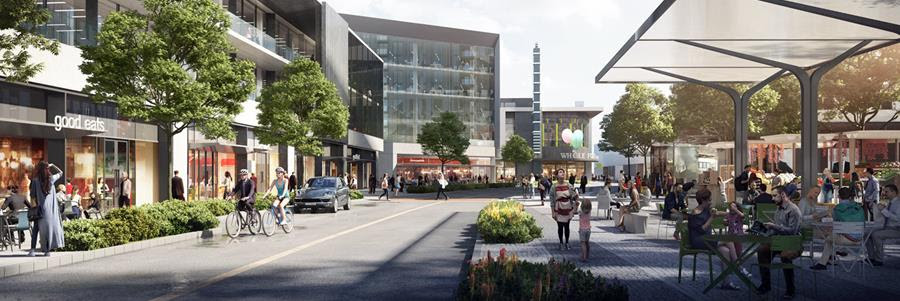Welcome to SV@Home’s Policy Rundown, your need-to-know overview of important housing policy actions and developments from the past two weeks. As we wrapping up the month of July, most City Councils have started their summer breaks and will not reconvene until August. This means the next several weeks will likely be quieter than normal on the policy update front, but we expect many critically important items to be high on Council agendas come August and the fall, so stay tuned!
Vallco Appeals Process Concludes + HCD Releases Latest SB35 Determination List
Last month, the final deadline passed for appealing a court decision that upheld the Sand Hill Property Company’s Vallco Town Center SB35 proposal, bringing to an end the years-long struggle over the dilapidated mall site in Cupertino. This is a major victory for the Cupertino residents who have worked so hard to bring new homes and affordable housing to their city, as well as for SB35, State Senator Scott Wiener’s 2017 housing streamlining legislation. With the demolition of the mall underway, SV@Home is looking forward in earnest to the 2,402 new homes planned for the site, including 1,201 affordable homes. We have been proud to stand with Cupertino residents who fought for affordable housing and will continue to support increased opportunities for housing for people of all incomes city-wide.
Relatedly, earlier this week, the California Department of Housing and Community Development (HCD) released its updated SB35 determination list, which designates the cities subject to the bill’s streamlining provisions based on progress towards meeting state-mandated housing goals. Jurisdictions that have made insufficient progress in permitting even above-moderate income housing are subject to streamlining if a proposal includes 10% of units as affordable. Those cities that have permitted sufficient above-moderate income homes but remain behind in their below-moderate income (low income and very low income) goals face the bill’s streamlining provisions for proposals that contain at least 50% of their units as affordable. The determination list requires that all cities in the County with the exception of Saratoga and Los Gatos, which are behind in meeting state goals for all categories of housing, meet the 50% affordability requirement.

Moffett Park Process Underway in Sunnyvale
On August 11th, the Sunnyvale City Council will hold its first study session on the Moffett Park Specific Plan, which was last updated in 2013. The Moffett Park area encompasses approximately 1,156 acres in northern Sunnyvale, currently dominated by office and industrial uses. The sheer size of the Plan area and its proximity to jobs and transit connections, including the VTA light rail system, makes it an excellent opportunity for pursuing housing development as part of new walkable, bikeable mixed-use neighborhoods. The potential for redevelopment in the area should be harnessed to create significant new affordable housing, which would be a major benefit to the Sunnyvale community. At the same time, we recognize that Moffett Park’s location along the shore of the Bay encompasses sensitive ecosystems and the proposed redevelopments will need to address issues of ecological restoration and climate resilience.
SV@Home looks forward to helping the city shape the Moffett Park Specific Plan through its community engagement process, and has submitted a letter laying out proposed housing principles for the area. Though the COVID-19 pandemic has somewhat delayed the city’s original timeline, Sunnyvale is aiming to present land use alternatives by the end of the year, with final plan adoption anticipated in Fall 2021. With this ambitious timeline, SV@Home is committing to working closely with the City of Sunnyvale, its consultants, and community members to create a Plan that creates significant new housing opportunities for people of all incomes.

Sunnyvale Downtown Specific Plan Updates and CityLine Mixed-Use Proposal (793 new homes!)
Also on the City of Sunnyvale’s agenda for next Monday are updates to the Downtown Specific Plan and a proposal by STC Venture LLC to bring 793 new homes to the downtown core. The proposed Specific Plan updates will provide the framework that enables the developer to make the proposal a reality. The CityLine mixed-use proposal is a major benefit to the Downtown and includes 88 deed-restricted affordable homes for families with very low, low, and moderate incomes. This affordability count and mix is based on the developer’s use of state density bonus law.
SV@Home has worked in coalition with Liveable Sunnyvale, the Silicon Valley Leadership Group, and Greenbelt Alliance to support these proposals. We will be submitting a joint coalition letter in advance of the meeting that endorses both the Specific Plan Updates and the CityLine proposal.

Diridon Station Area Returning to the Fore in San José
This Fall is going to be busy for the Diridon Station Area planning process as, despite initial delays caused by COVID-19, the City of San José is getting back on track with its schedule. A number of critical city documents and plans will be released and taken up by the City Council starting in September, so we need advocates to be ready to stand up and support 15,000 new homes in the Station Area, 25% of which must be affordable per the City’s adopted requirement.
Here are some of the anticipated important dates:
- Mid-August – The City of San José releases the draft of its City-wide Anti-Displacement Strategy
- September 8th – The Downtown West Draft Environmental Impact Report (EIR) is released
- Mid-September – The City of San José releases the draft of its Diridon Station Area Housing Strategy
- September 16th – The Station Area Advisory Group (SAAG) meets to discuss the Downtown West EIR and the latest updates on the Diridon Station Area Plan (DSAP) process
- September 24th – The City Council will hold a study session on the DSAP, the Downtown West Draft EIR, and the negotiation of a Development Agreement with Google, including the proposed community benefits package
- October 2020 – The City anticipates hosting a public community meeting addressing all of these items
Get ready for opportunities to take action, and stay tuned to SV@Home’s email alerts and newsletters for more information. And for the latest update on SV@Home’s position on housing in the Station Area, check out our Diridon page here.
San Jose adds two measures to the November Ballot
With just 90 days remaining until Election Day– November 3rd– San José voters will be asked to weigh in on two City-sponsored ballot measures.
One measure will amend the city charter to expand the City’s Planning Commission from seven to eleven members to ensure racial and geographic diversity and representation. SV@Home recently joined other nonprofit organizations in advocating for this increased Commission representation. To save money, this measure will be consolidated on the ballot with two unrelated charter amendments into a single ballot measure—expanding the review authority of the city’s Independent Police Auditor and adjusting redistricting guidelines. Read more here.
A second measure to increase the City’s existing Cardroom Business Tax along with increases in the number of card tables allowed could generate approximately $11 million, which could be used to fund a variety of city services, including homelessness response and support for vulnerable residents.

Update on Tenant Protections at the County, State, and Federal Levels
With federal unemployment benefits and a federal eviction moratorium expiring at the beginning of August, there has been increased confusion around the protections and resources available to vulnerable tenants in Santa Clara County who are at risk of losing their homes. Here is a rundown of the latest developments at the County, State, and Federal levels:
County of Santa Clara
- Santa Clara County’s Eviction Moratorium for renters who have lost their job or been affected by COVID-19 remains in effect through August 31st. In order to be protected under the moratorium, renters must notify their landlords of hardship. Visit the County’s website to download the required forms.
- It is important to note that the moratorium does not relieve renters of the obligation to pay rent. Once the moratorium ends, renters will have six months to pay off 50% of the back rent they owe, and six more months to pay off the remaining 50%.
State of California
Multiple rent relief proposals are currently being considered in the California State Legislature. Chief among those are AB 1436 (Chiu) and SB 1410 (Caballero/Bradford). Both of these bills are undergoing amendments as negotiations continue in the Legislature.
- AB 1436 would prohibit the eviction of tenants or homeowners who cannot pay their rent or mortgage due to loss of income related to the pandemic through 90 days after the end of the current state of emergency, or April 1, 2021, whichever is sooner. Tenants would have one year to repay the unpaid rent, and homeowners would be entitled to one year of mortgage forbearance.
- SB 1410 would void any demand for unpaid rent accrued during the state of emergency, which began on March 4th. It would then establish a voluntary program where landlords could obtain tax credits for unpaid rent, and tenants would be responsible for repaying their back rent to the state between 2024 and 2034.
Federal Action
Negotiations are moving forward slowly in Washington, but we hope they will reach agreement soon on several key points, including the extension of the supplemental unemployment payments and the extension of the moratorium on evictions for federally backed housing as well as rental assistance to help tenants who have fallen behind on their rent.

